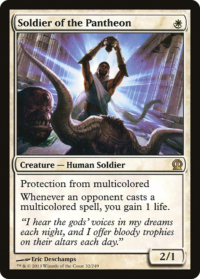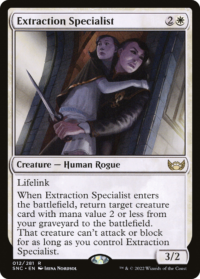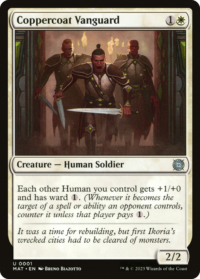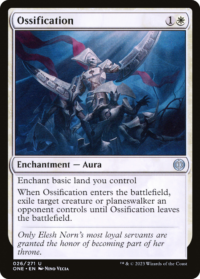Thalia, Guardian of Thraben is a card that has stood the test of time. Her simple yet elegant design has proven to be everything that a white aggro deck could ask for, from her cheap rate to her obnoxious tax on removal spells and other things that most players would consider “fun.” Roughly a year ago, I showed off my first take at a Pioneer deck featuring this sublime card and all of her friends, and in the time since, Mono-White Humans deck has absolutely exploded in popularity. A lot has changed since last year, and this archetype is no exception, becoming one of the most streamlined decks in the format while still maintaining that modularity that drew me to it in the first place. Since Aftermath has dropped yet another new card for the deck into our laps, I figured that it was time to update our old friend, the best budget competitive deck in Pioneer, Mono-White Humans.

Budget Pioneer Humans by Darren Magnotti
Deck 4 Dauntless Bodyguard 4 Recruitment Officer 4 Soldier of the Pantheon 4 Thalia's Lieutenant 4 Thalia, Guardian of Thraben 3 Adeline, Resplendent Cathar 4 Coppercoat Vanguard 4 Luminarch Aspirant 4 Ossification 2 Brave the Elements 1 Extraction Specialist 3 Mutavault 3 Shefet Dunes 16 Plains Sideboard 3 Brutal Cathar 1 Anointed Peacekeeper 2 Containment Priest 2 Invasion of Gobakhan 2 Reidane, God of the Worthy 3 Portable Hole 2 Soulless Jailer
Since we’ve already been introduced to this deck in the older article (you did reread that one just now, didn’t you?), I won’t get too lost in the weeds with how it operates. The basics are that it’s a streamlined creature beatdown strategy focused on filling the board with cheap and efficient Humans, pumping them up via +1/+1 counters or lord effects, throwing off the opponent’s game plan just enough to sneak by, and smashing the opponent’s face in.
The New Guy
The reason that we’re here today is a new card called Coppercoat Vanguard, an addition to the Humans deck that everyone saw coming and that the deck desperately needed. At the moment, Pioneer is somewhat plagued by what some are calling the Rakdos Menace. A pile of the most efficient threats and removal in the format, Rakdos Midrange is certainly on everybody’s radar as the top dog to beat right now. Humans, and more generally all aggro strategies, tend to struggle with the game plan that Rakdos is following because when your opponent is focused on removing all of your creatures, playing the creature deck tends to get difficult. That’s where the Vanguard comes in. Giving each other creature ward 1 acts like a second Thalia, slowing the opponent’s efforts to thwart your own game plan by what could be one crucial turn. Even if the Vanguard ends up acting like a sponge for removal, that could be the difference between your real threat sticking around to connect and it dying on the spot. This effectively turns the Vanguard into the biggest threat on every board state, regardless of whatever else you have in play.
Over the last six months or so, many Human cards have been slotted into the Mono-White deck for testing, and few have come out victorious in earning their keep. Coppercoat Vanguard is an amazing piece of technology that answers a lot of the questions that Humans was asking of its pilots, while also providing some ease-of-access for those of us who are more wallet-conscious. Between the extreme number of reprints that the cards in this deck have seen and the fact that you can reasonably assemble half of it from the uncommons bin at your LGS, Humans has become a reasonable contender for the title of best budget deck in the format. There are a few things to note about it before picking it up though, so let’s get into why I feel that this particular version is poised to perform right now.
Important Matchups


Rakdos isn’t the only threat to worry about though, as Devotion has also seen a bit of a resurgence thanks to the addition of Polukranos Reborn. Devotion has been a fair to good matchup for Humans in the past, though as it started to scale back around the time that the Pro Tour was happening, players started leaning more and more heavily on Ossification rather than their go-to noncreature spell in Brave the Elements. Brave also happened to be the major reason that Humans could beat the Devotion deck in the first place, so going back to the deck’s roots in that regard is also a must.
One huge reason that Humans is poised to perform at the moment is that Phoenix, yet another of its old nemeses, is relatively absent from the format. With this secondary threat of a deck being less prevalent, Humans is able to lean into its one major bad matchup and cover its bases more effectively. In a more narrow metagame, it’s a lot easier to prepare when you can pinpoint the exact threats that you need to answer. So not needing to prep for Phoenix on top of needing to prep for Rakdos means that these efficient aggro strategies can really focus on what’s important for that one crucial matchup instead of spreading their responses out and diluting their own game plan, as was the case in last year’s article.
“Honestly, the deck felt more like a Death and Taxes pile than a generic beatdown deck, which is a good place for White Weenie to be. I think that this deck has a lot of potential moving into the future of the format, and with enough eyes on the strategy, an optimized list is sure to turn up eventually.”
We can see just how both right and wrong I was about the archetype in two sentences. Streamlining the deck has certainly increased its viability, and trying to emulate a Death and Taxes style without the cards that make that strategy good was not the way to be. Originally, Humans was a value-oriented Collected Company pile rather than the beatdown deck we’ve grown to know, and I think that it’s evolution is for the best, when taking into account competitive viability.
Upgrades
Pioneer Humans by HermonHero
Deck 4 Mutavault 3 Brave the Elements 1 Kytheon, Hero of Akros 4 Thalia's Lieutenant 2 Shefet Dunes 4 Dauntless Bodyguard 4 Luminarch Aspirant 4 Adeline, Resplendent Cathar 4 Hopeful Initiate 2 Eiganjo, Seat of the Empire 12 Plains 4 Recruitment Officer 4 Ossification 4 Coppercoat Vanguard 4 Thalia, Guardian of Thraben Sideboard 3 Rest in Peace 1 Portable Hole 4 Brutal Cathar 4 Wedding Announcement 3 Invasion of Gobakhan
Upgrading the deck is about as easy as picking it up, as well. Some key factors to consider are the lands; though Mutavault has maintained a relatively low price thanks to its Commander deck printing, Eiganjo is still a crucial piece. Hopeful Initiate is a very strong card that plays well into the midgame with its ability to pick off a surprising number of cards like Skysovereign, Consul Flagship, Reckoner Bankbuster or Leyline Binding. It was omitted here just because there are so many alternative one-drops that could be showcased, but honestly it’s the best of the bunch by a long shot. Otherwise, the sideboard is the only other place that needs work. Wedding announcement will help the deck hang around when those midrange piles sideboard into their control-suite, and Rest in Peace will do a much better job than Soulless Jailer at keeping a deck like Greasefang at bay.
That’s all for this one. This was my first crack at updating a deck, and I feel like this new version is going to do a much better job at doing what it’s supposed to – offer a competitively viable entry point into the format. Not to rag on my old work, but sometimes a deck list can just get left in the dust as the format continues to evolve and grow. Hopefully we can emulate that as players, keeping up with and getting over all that comes our way both at the competition table and in our real lives. Until next time, stay safe, play smart and thanks for reading.


